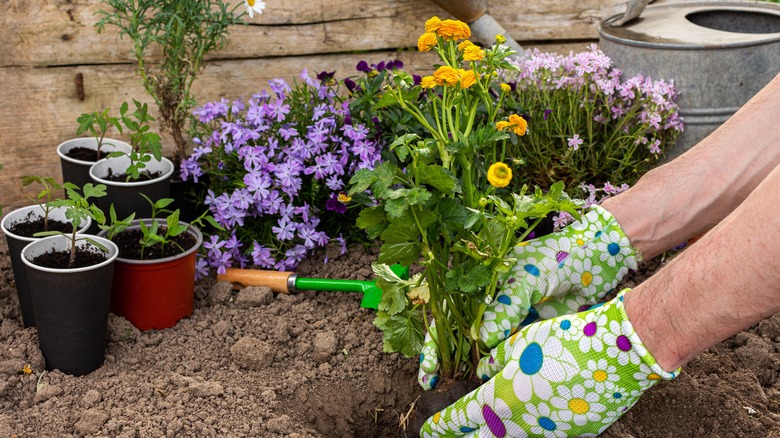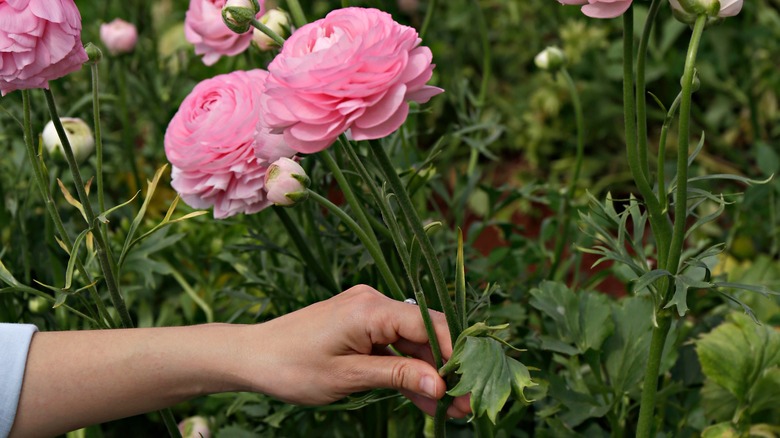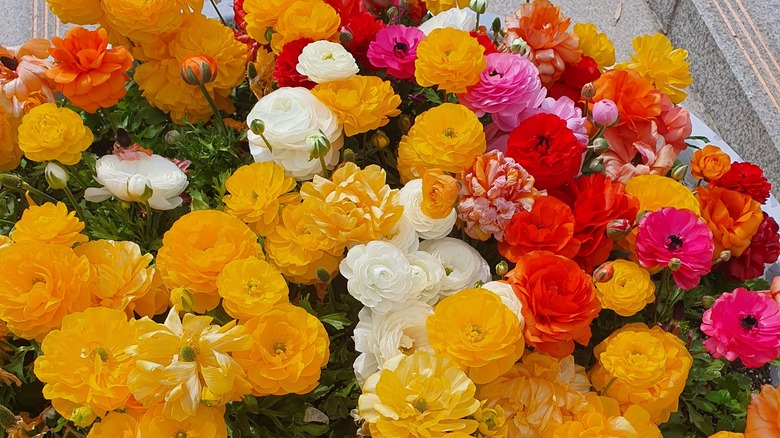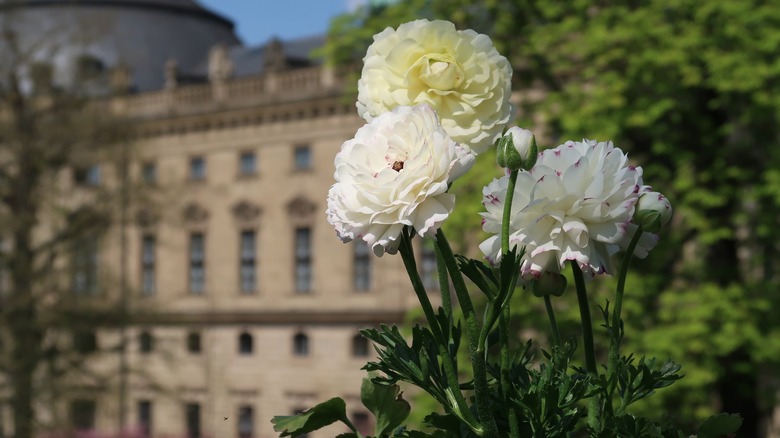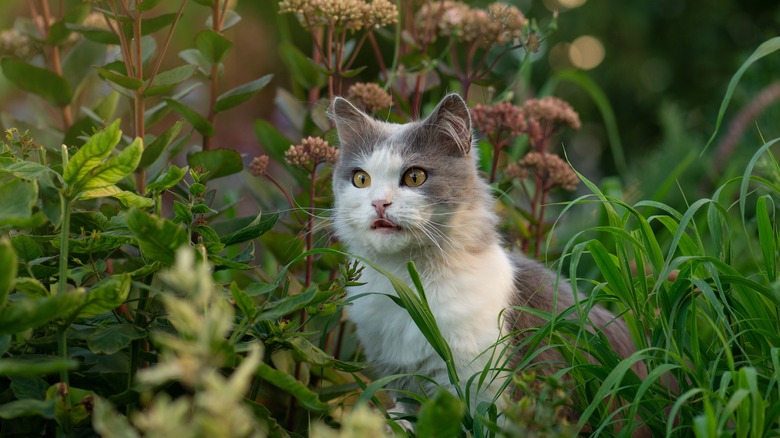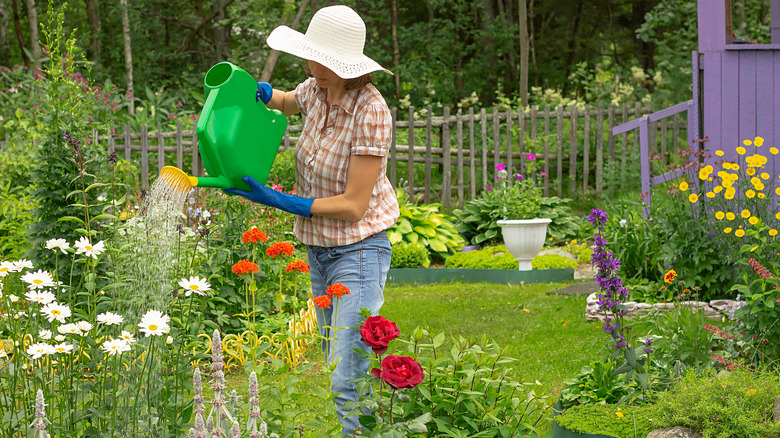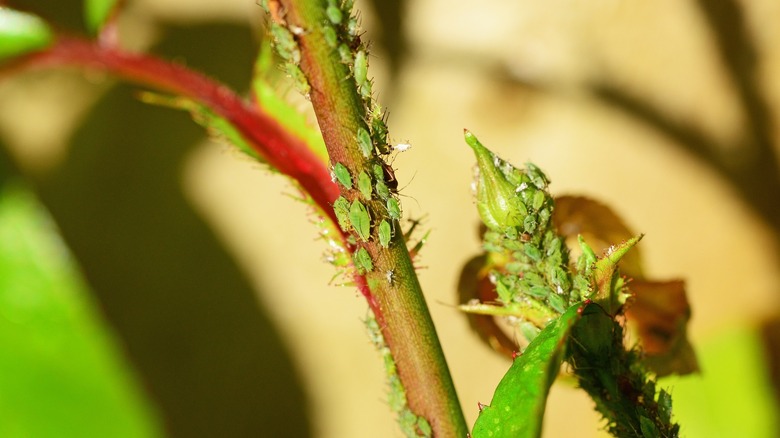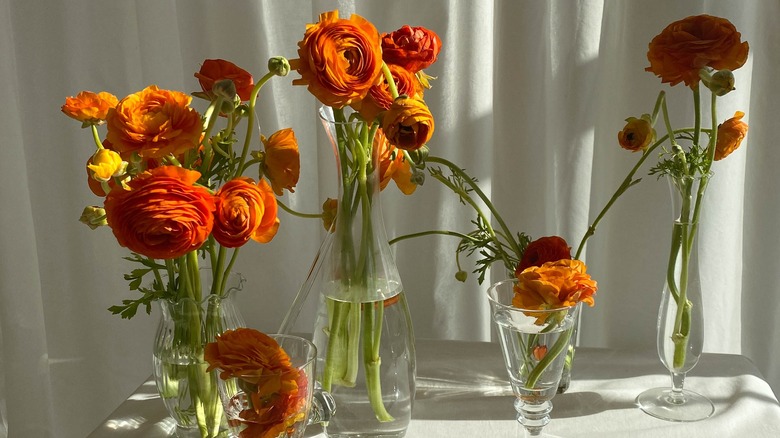Ranunculus: Everything You Need To Know Before Planting
People have been gardening since the earliest civilizations, though the first ornamental gardens weren't seen until the establishment of settlements were well-established with classes and hierarchies. Only the wealthy had gardens back then, but in modern times, nurturing flora is a hobby enjoyed by people from many walks of life. Whether you're new to gardening or have experience raising dozens of plants from seedlings, it's important to know the proper caretaking procedures that are appropriate for different species.
Ranunculus is a genus of flowers and refers to hundreds of plants commonly seen in bouquets, wreaths, and vase displays. Their vibrant colors are sure to enliven any room or garden, but you need to know how to nurture these flowers to ensure they stay healthy and maintain their appearance.
Before you plant ranunculus, there are many considerations to keep in mind that will determine your gardening success. You should know all the basics about growing ranunculus, including their preferred climate, nutritional requirements, pruning needs, potential problems, and what to expect throughout their lifespan. Learn more about these plants and how to raise them below.
Which areas are the most habitable for ranunculus?
Professional gardeners and growers follow a chart created by the United States Department of Agriculture (USDA) known as the "Plant Hardiness Zone Map." This handy guide divides the US into territories based on average winter temperatures and 10-degree Fahrenheit differences.
It sets a standard that casual and professional planters follow to ensure their plants can thrive in a given location. If you want to grow ranunculus flowers in your garden, you're in luck, they can survive in growing zones three through ten under the right conditions, meaning they can be planted anywhere in the contiguous United States.
However, keep in mind that these plants do grow best in places with mild winters, meaning they're best suited for zones eight to ten. If you want to raise them in colder zones, which are those labeled seven and below, you'll need to lift them during the winter. This requires digging them out of the soil before the ground freezes over and storing them in dry spaces with sun exposure until spring.
Which spot in your garden is the most ideal?
When deciding where on your property to place your ranunculus, you must consider the drainage, soil fertility, sun exposure, and proximity to other plants. This flower species can be grown in pots or directly in your yard as long as its needs are met. When planting directly into an outdoor garden, you can determine how well your landscape drains by observing the ground after the rain. Water should soak into the soil shortly after rainfall, but if there are still puddles hours later, your property does not have proper drainage for a ranunculus plant.
You also need to ensure the soil is healthy enough by measuring its pH level. Use a soil test kit, which you can purchase at most home improvement and gardening stores, to determine the acidity and nutrient levels present in the ground. If the dirt falls short of nitrogen, phosphorous, and potassium content recommendations, specific types of fertilizer can help you revitalize your landscape for planting.
You also need to consider sun exposure; this plant should be placed in areas with full sun, although it can also be placed in partial shade if in a hotter hardiness zone. When planting, make sure each bulb is burrowed about two inches deep and four to six inches apart. You should follow this template when placing the bulbs in pots as well.
When to plant ranunculus
Planting bulbs and seeds during the right seasons is the best way to ensure your garden's survival. As a general rule of thumb, the best time to start new seeds and bulbs is during the dormant season. This gives your flowers time to establish their roots and grow before having to survive extreme weather conditions, specifically hot summers and freezing winters.
The dormant season usually falls between late fall and early spring in the United States, though the proper time to bury a ranunculus bulb depends on what zone you reside in. If you're in zones three to seven, you should plant in the late spring to ensure your flowers bloom before autumn arrives.
However, if you live in zones eight through ten, you should bury the bulbs in the late fall since winters are milder, and it won't be as tough for your ranunculus to mature. Remember that if you plant them outside of the ideal times mentioned above, it may take extra care on your behalf to ensure the new flowers stay healthy.
The best companion plants
Ranunculus flowers are available in many different color varieties, including shades of pink, red, orange, yellow, and white. From an aesthetic standpoint, you don't need to stick to a strict color scheme when planting a flower garden since flowers look beautiful when paired with contrasting and complementary shades alike. However, you may want to choose other flowers that thrive under similar conditions to make maintaining your garden easier throughout the year.
The ranunculus family includes around 300 species of flowering plants, giving you hundreds of buttercups to choose from and incorporate into your garden. The buttercup flowers will grow well with other plants that prefer the same mild climates. You may also want to consider other flower families that bloom at the same time of year, so you can appreciate your garden with all its flowers on display. Some popular companion greenery for the ranunculus classification group includes African daisies, Chinese forget-me-nots, pansies, primroses, snapdragons, and sweet pea plants.
What colors should you pick?
It's already been discussed how gardens are versatile, and most color combinations are aesthetically pleasing, no matter how much they contrast. However, you can still stylize your landscape by choosing flowers that complement each other and your home's architecture. Buttercups and other ranunculus varieties are often characterized as romantic and traditional flowers, making them well-suited for old-fashioned dwellings, such as Victorian-style architecture.
The color of the home will have a significant impact on the shade of the flowers that you plant. Many people choose flower colors that correlate with their siding, roof, entry doors, and window colors. Neutral-colored architecture is beautified when paired with reds, pinks, and yellows, making ranunculus a great fit for white, gray, beige, or tan siding. If you have a brick home, you may want to choose ranunculus varieties that match the tones of orange, red, or brown in your masonry.
The toxicity of the flower
You should always know what you're planting in an outdoor garden. Many plants are toxic to humans and animals alike, making your plants potentially dangerous to pets, people, and natural wildlife. Ranunculus is one of those species, and it's toxic through contact and consumption. Crushing the leaves releases a compound that leaves a rash on your skin, and swallowing them causes an upset and painful stomach and dizziness. The plants are more poisonous when they're in bloom, where worse symptoms have been recorded.
It's highly recommended that you keep outdoor pets out of gardens with this plant by keeping them on leashes or putting up a fence around your perennials. You should keep an eye on children with curious appetites and also warn younger family members to stay away from the plants, warning them about their poisonous qualities. On a positive note, buttercups are not toxic to deer and rabbits, making them safe for wildlife in your community.
How to care for them
Ranunculus require similar watering techniques to many plants; you want to keep them moist but avoid overwatering, which can cause their bulbs and roots to rot. When they're first planted in soil, you should water them well and then withhold further hydration until the bulbs sprout. Otherwise, you risk over-saturating the bulb, drowning it, and causing mold growth. If your plants are left outside during the winter, you should scale back watering during that time of year: Don't worry; these are perennials, meaning their blooms will revive during the spring.
You should routinely prune these perennials while they're blooming through deadheading. Deadheading is the removal of dead or dying flowers, which keeps your plants looking vibrant and colorful. This practice removes dying pieces that waste your plant's energy, keeps your plant healthy, and the second bloom often lasts longer than the first. After the first frost or cold front in fall, you should cut this plant again to remove the dead growth.
You may need to alter your chosen fertilizer based on companion plants and soil fertility. However, flowers generally need a fertilizer with a higher middle number. The first number is nitrogen, the second stands for phosphorous, and the third represents potassium, and most perennials require fertilizers with higher ratios of phosphorous. Don't forget to dilute the fertilizer with water according to your chosen brand's instructions. You should fertilize about six weeks after planting and then roughly once a month throughout the growing season.
Pests and diseases to watch out for
Like all natural living things, ranunculus plants are vulnerable to pests and diseases. Mildew is the most common disease to afflict this plant. This fungus-caused condition is easy to identify as it leaves patches of white and gray coloring on your plants. It infects all parts of a plant, including the leaves, stems, buds, and flowers, causing the plant to droop or fail to bloom if the infection is allowed to fester.
The issue is exacerbated by late-summer fertilization, over-watering, and high temperatures with high humidity. Although powdery mildew thrives in warm, humid conditions, this infection won't disappear on its own, even when exposed to colder temperatures in later seasons. Organic fungicides are the best treatment method, but they must be used prior to an infection or in the early stages.
Aside from fungi, your ranunculus plants can also fall victim to aphid infestations. Aphids are tiny insects that feed on stems and cause leaves to discolor and wilt. You can remove these creatures the same way you'd treat a fungal infection; by using a specialized spray. Birds are also a risk for newly sprouted bulbs, as they will eat them during their younger stages of growth. You may need to cover your plants with garden wire or nets to protect them until they are old enough to flower and are no longer a delicacy for birds.
What to expect from the flowers
It's in your best interest to know what to expect after planting these vibrant perennials. They take about two weeks to sprout, and they have a long growing period of about two to three months before they bloom. They tend to flower for around a month to six weeks, though this time can be extended by proper pruning practices, which enable plants to put more energy into flower production.
Remember that perennials only bloom for one season, so you should only expect a ranunculus's flowers to bloom once per year throughout their lifespan. These flowers can brighten your garden for more than three years when correctly cared for and unafflicted by pests or disease.
If you have other plans for this plant and want to snip the flowers to create a bouquet or vase arrangement, there is a strategy for ensuring they maintain their vibrancy for as long as possible. Cut the stems when they form colored buds but haven't opened up yet, and they will bloom and last up to ten days in an arrangement. These flowers are also great for adding color and vibrancy to seasonal wreaths, though they must be thoroughly dried first.
